30 January 2009 | Author: Chip Taylor
The year 2009 marks the eighteenth year of Monarch Watch. We started the program in the fall of 1992 and, given the economic conditions, I’m wondering if we will still be around next year at this time. Keeping Monarch Watch going from year to year has always been a concern yet somehow we have managed. In fact, we are one of the longest surviving educational outreach programs in existence. Most such programs have initial funding from grants, corporate benefactors, and contributions but only keep going for a year or two after the initial funding runs out. I don’t know the half-life of outreach programs that are similar to Monarch Watch, but I’d guess that it’s roughly 5-6 years. If this is the case, we have done relatively well. But, can we keep it going?
At a recent meeting, the discussion turned to the funding of non-governmental organizations (NGOs) and the statement was made that most NGOs are anticipating declines in revenues of 20-40% in the next year. I’ve heard similar concerns on NPR and on local radio stations as well. Monarch Watch might be able to survive a 20% drop in revenue but not 40% or even 30%. So, what is the prospect for the future? We’ve been looking at the books and it doesn’t look good. Last year our expenses exceeded our income by $18,000 – clearly, we need to increase our income and it’s really an open question as to whether we can do so.
Our 2008 income and expense breakdown is as follows:
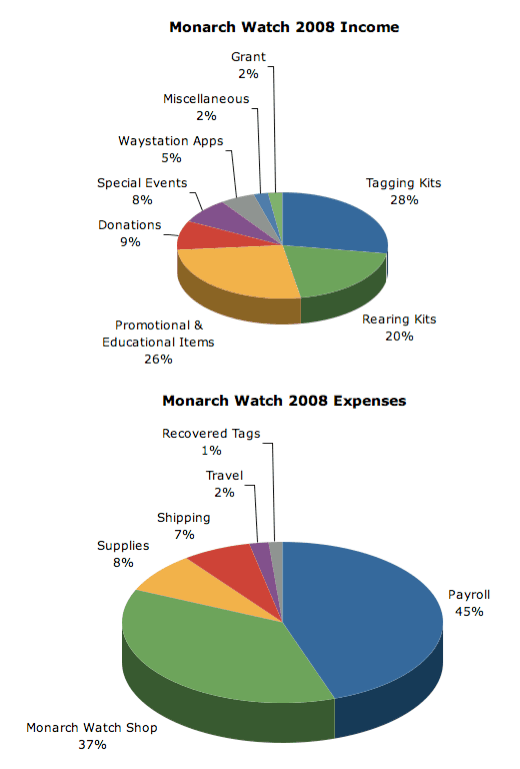
The tagging program doesn’t pay for itself and we can’t cover all the costs associated with buying tags in Mexico, so I have been paying for most of the tags from personal funds.
Why We Need to Survive
For the last 14 years I have been advocating the creation of a cohesive plan to conserve the monarch migration, a plan that involves all three countries that host the eastern monarch population. I won’t go into the history of this advocacy, and I’m not sure it ever had any impact, but the reality is that such a plan has been developed and we now have the “North American Monarch Conservation Plan”. This is an exciting development and we want to be in a position to support this plan in the coming years. The plan was developed through an extensive set of meetings and communications involving representatives of Mexico, the United States, and Canada.
The first positive steps toward international cooperation to conserve monarchs occurred at meetings of the Trilateral Committee for Wildlife and Ecosystem Conservation and Management. These meetings, aided by the hard work of Donita Cotter and others, led to The Trilateral Monarch Butterfly Sister Protected Area (SPA) Network, a partnership of wildlife refuges and national parks in the United States and Canada, and natural protected areas in Mexico. Subsequent meetings involved monarch scientific and conservation experts and other stakeholders who met in Mission, Texas in 2006 (supported by the U.S. Forest Service) and in June 2007 in Morelia, Mexico (supported by the Commission for Environmental Cooperation of North America (CEC)). Karen Oberhauser (Monarchs in the Classroom/Monarch Lab) was the lead organizer and writer of the plan and her hard work, as well as that of Donita Cotter (USFWS) and a multitude of contributors, resulted in a plan that WILL serve as the basis for an upcoming focus on the protection, enhancement, and restoration of monarch habitats in the United States.
Announcements about developments related to this plan and monarch conservation will be forthcoming in a few months. Suffice it to say that a goal is to unite all parties interested in monarch conservation. To contribute to this encouraging development in coming years, we need to keep Monarch Watch going and to do so we will need help.
How You Can Help Monarch Watch and Monarchs
If you would like to help us continue our work on monarch conservation, here are some suggestions:
• Make a single or recurring donation online or by mail – contributions are 100% tax-deductible and many employers will match your gift.
• Register your monarch habitat with us as a Monarch Waystation, if you haven’t already done so.
• Encourage others to create habitats and register them as Monarch Waystations.
• Visit the Monarch Watch Shop to purchase educational and promotional products.
• Attend our Spring Open House and Plant Fundraiser on 9 May 2009.
• Organize fundraisers on behalf of Monarch Watch.
• Help us find a corporate sponsor.
Monarch Watch Mission and Vision Statements
We have always described Monarch Watch as an outreach program that deals with education, research, and conservation of monarchs but we are much more. We truly have a mission and vision but we have never made these views clear to the public and our participants.
Mission Statement: Monarch Watch strives to provide the public with information about the biology of monarch butterflies, their spectacular migration, and how to use monarchs to further science education in primary and secondary schools. We engage in research on monarch migration biology and monarch population dynamics to better understand how to conserve the monarch migration. We also promote protection of monarch habitats throughout North America.
Vision Statement: In recognition of the rapid loss of habitats and resources needed by monarch butterflies in the United States, Canada, and Mexico, our vision is the preservation of the monarch migration will require stewardship by the governments and private citizens of all three countries. We all must work together to create, conserve, and protect monarch habitats. Sustaining monarch habitats will have the effect of protecting vital pollinators and other wildlife.
What We Do at Monarch Watch
Annual and Ongoing Activities
Listed below is a summary of the major things we do at Monarch Watch – Jim, Ann, and I wear many hats around here and it would be impossible to list EVERYTHING we do.
• Manage the monarch butterfly tagging program
• Create educational materials based on monarchs
• Manage the Monarch Watch website
• Manage the Dplex-L email discussion list
• Manage the Monarch Watch Forums
• Provide periodic updates on monarchs via our Blog
• Distribute caterpillars and educational materials to schools
• Give general and professional talks on monarch biology (~12/yr)
• Videochat with classrooms (Q&A sessions with students) via iChat or Skype
• Respond to thousands of emails and dozens of press inquires
• Advise teachers and students on classroom and independent projects
• Summarize and publish tagging data
• Track monarch population trends and develop models to predict population size
• Host Spring and Fall Open House events for the public (400 to 1000 attendees)
• Conduct a public tagging event at Baker/Haskell Wetlands (150 to 550 participants)
• Promote Monarch Waystations to engage the public in monarch conservation
• Give tours to school groups, garden clubs, and many individuals that visit us
• Serve as a resource for numerous documentaries on monarchs
Monarch Watch Projects and Activities for 2009
Seek funds to analyze the tagging data
The tagging database is enormous, with more than one million records of tagged monarchs and close to 13,000 recoveries. We need to analyze these data and that will require funds to validate and standardize the entries. This is no small task and will require hundreds of hours. Although most of the questions we want to ask of the data, such as recovery rates for each section of the country, are clear, we anticipate that new questions will arise as answers to the first questions become apparent. The biggest challenge will be to test two major hypotheses regarding the migration, namely that it is driven by weather or is coincident with celestial changes. Gathering the weather records for the United States for each migration over the last 17 years will also take lots of hours. We anticipate that this project will cost 40-50,000 dollars.
Blog – more frequent entries
We got off to a great start with the Blog in early 2008 but got away from this task as the season progressed. We are going to post entries more frequently in 2009. You can expect to read much more about monarch conservation this year – things will be happening.
Reorganize the website
We have so much on our website that I’ve forgotten much of it. But, more importantly, I can’t find ancient texts when I do remember them. So, we have to find a student or intern who can take the time to go through old texts and organize them so that the information is more accessible to all.
Continue research on monarch population dynamics
We are making progress on an analysis of the relationship of climate to the numbers of monarchs reported at the overwintering sites and other locations. Stay tuned – the results will surprise you.
Promote phenology project more effectively
Last year we encouraged you to start tracking the phenology of the milkweeds in your gardens or familiar monarch habitats. For various reasons this project got off to a slow start. We are going to try again this year so watch the Blog for more information.
Promote Monarch Waystations with the goal of registering more than 1,000 new Waystations in 2009
The Monarch Waystation message requires constant promotion. We need to engage more gardeners, schools, nature centers, botanical gardens, property owners, municipalities, businesses, homeowners associations, zoos, and others to create Monarch Waystations. Given that we are losing 6,000 acres per day due to development, monarchs need all the help they can get. Please help us get this message to others.
Develop and implement a closed breeding system to control disease in monarch cultures
This project has been a long term goal; we are not there yet but we are getting closer.
Continue the tagging program for the 18th year
Tags may now be ordered via the Monarch Watch Shop for distribution in July/August – in plenty of time for the migration in your area.
Assist with and promote the North American Monarch Conservation Plan
We will have a lot more to say about this plan soon.
Thank You For Your Continued Support!
Filed under General | 14 Comments »
 Daniel Mosquin, Education and Technology Manager at the UBC Botanical Garden and Centre for Plant Research, recently posted some photos and video taken at the Sierra Chincua Monarch Butterfly Reserve in Mexico. If you’d like to learn a bit more about Oyamel fir trees (Abies religiosa) – a major element of the monarch’s overwintering habitat – head on over to:
Daniel Mosquin, Education and Technology Manager at the UBC Botanical Garden and Centre for Plant Research, recently posted some photos and video taken at the Sierra Chincua Monarch Butterfly Reserve in Mexico. If you’d like to learn a bit more about Oyamel fir trees (Abies religiosa) – a major element of the monarch’s overwintering habitat – head on over to:![]()
 Last year at this time I was working with a BBC Radio crew in Mexico to record observations of the overwintering monarch population – as a part of their “
Last year at this time I was working with a BBC Radio crew in Mexico to record observations of the overwintering monarch population – as a part of their “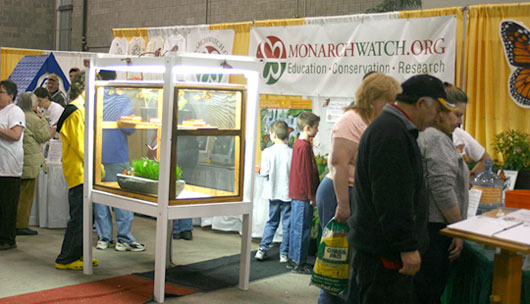

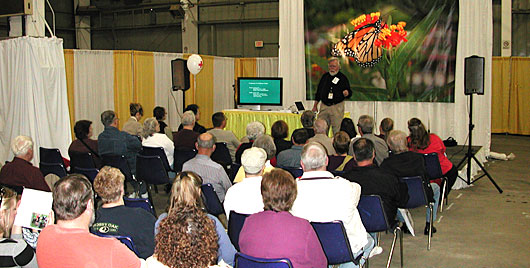
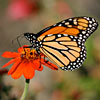 Spring’s just around the corner! The
Spring’s just around the corner! The 

 Come visit us this Saturday – in person or online!
Come visit us this Saturday – in person or online! 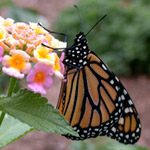 Our recent
Our recent 
